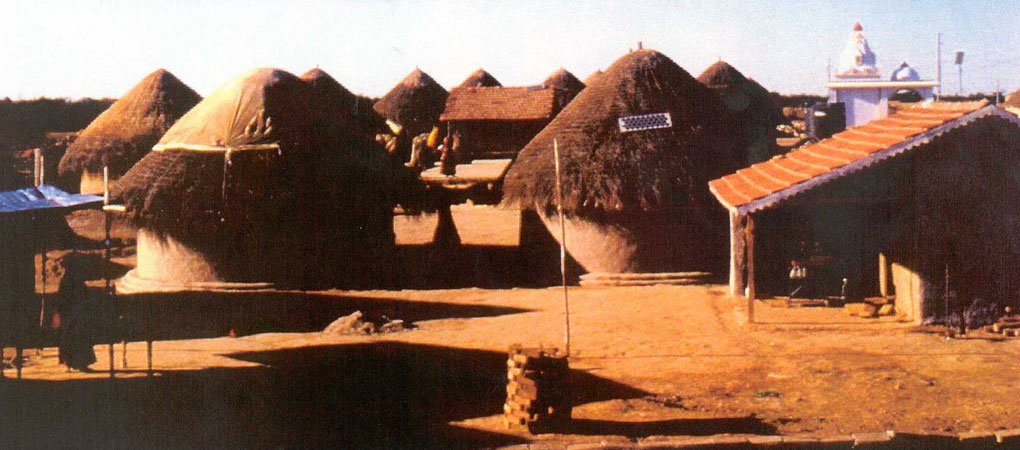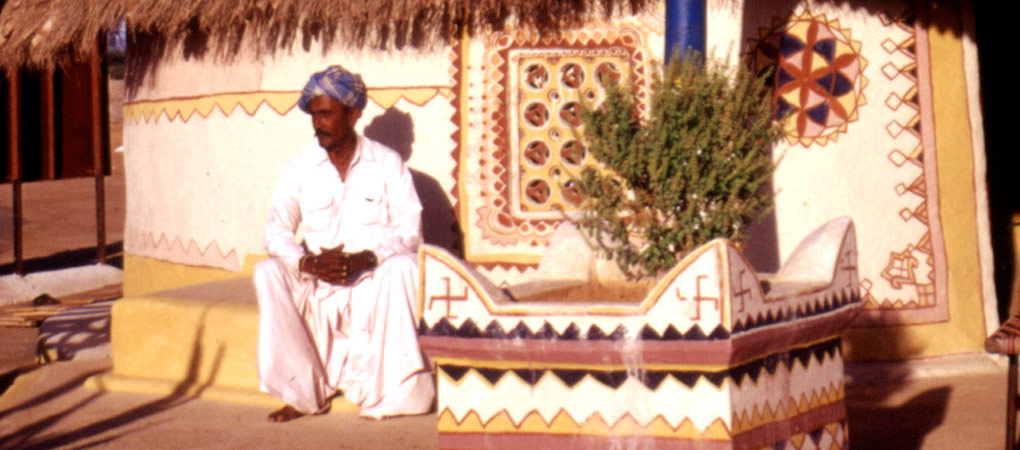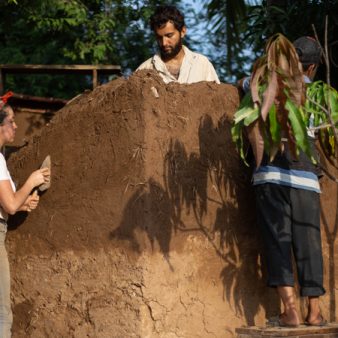Project Description
A devastating earthquake measuring 6.9 on the Richter scale struck the state of Gujarat in India in January 2001 leaving 20,000 dead and millions homeless. The worst hit area was the region of Kutchchh. This is a hot arid area with hamlets spread over the remote areas of the desert. The traditional houses here are circular, built with adobe bricks and a conical thatch roof and are richly embellished with clay and mirror relief work. Art, culture and architecture are symbiotically interwoven. Each dwelling consists of two to three bhungas (circular dwellings) on a plinth compound. Younger people have abandoned these in favour of rectilinear stone and concrete houses. After the earthquake it was found that the circular houses were still standing whereas the rectilinear ones were completely destroyed. Many villages and hamlets were devastated in the earthquake. Gandhi Nu Gam was one of these.
Vastu-Shilpa Foundation (VSF) for Studies and Research in Environmental Design took up the initiative and involved itself with the rehabilitation processes for thirteen earthquake affected villages including Gandhi Nu Gam.

The local people were involved throughout the planning process. This included a reconnaissance of the existing settlements and a discussion of needs, aspirations and requirements. These were then translated into plans for discussion by the local community. Feedback and redesign continued until all the residents were satisfied.
VSF set up an office in the village for the duration of the work and this enabled them to have a closer understanding of the village way of life and engendered trust from the local people. Surveys were carried out to ascertain the existing conditions and a site plan was developed based on the traditional patterns of clusters around open spaces.
Training and provision of tools and other facilities were provided to encourage the restoration of local income generating opportunities after all previous infrastructure had been destroyed in the earthquake. Improvements to the farming system (check dam and pond, new farming methods) were introduced to ensure higher levels of agricultural output.
All materials used in construction are locally produced. The adobe blocks are made from the local earth and dried in the sun. Windows and doors are made on site using local timber. The design and production of the adobe blocks using a ram was informed by government guidance on appropriate technologies.
The total cost for 455 houses, community centre, infrastructure, health and education facilities was US$630,000. The cost of each dwelling was US$740, of which 20 per cent was met by the resident in terms of land, labour and materials. A range of partners were involved in the financing of the project. In addition to Manav Sadhna and GMDC funding was also received from the government sponsored Council for Advancement of People’s Action and Rural Technology (CAPART) and the Rejuvenate India Movement (a collaborative council of various NGOs involved in rural development) that provides training for workers in the villages.
Why is it innovative?
- Participatory design and development
- Continuity of tradition as well as using the opportunity for change
- Sustainable development (environmental and social)
- Integrated development – provision of infrastructure, opportunities for income generation
- Use of technologies appropriate to an earthquake-prone area
What is the environmental impact?
The houses are constructed using locally produced materials and appropriate technology. The sources of water supply are improved with check dams and water harvesting ponds. There is also provision of solar powered lighting. Wastewater from the bathing rooms and the decomposed waste from the pit latrines are used to improve vegetable cultivation. Trees are planted in and around the settlement to create green areas and promote environmental sustainability.
Is it financially sustainable?
A range of economic opportunities have been established. These include a community crafts centre, a building materials bank, a retail outlet, animal care centres and grass banks.
The construction of check dams permits an extended farming season and reliable water availability over an extended period of time. Alternative methods and techniques of agriculture have been introduced through an awareness and education programme. The supply of construction materials has become a source of employment. Facilities and tools have been provided for craft workers to carry out their trades and training provided for local people. Additional training has been provided on product design and marketing. Provision of a water supply/sanitation has reduced the time taken for daily chores by the women, freeing them up for productive/creative purposes.
What is the social impact?
The entire project was predicated on the participatory process with all villagers involved in the designing and planning of their new village. Residents were involved in all key decisions including choice of relocation site, settlement patterns and the dwelling type.
Two mosques and temples have been renovated/rebuilt by the villagers, using their own initiative and effort. There is increased cooperation between people of different faith traditions.
There are further indications that the traditional low status role of women is changing. These include the fact that women are active partners in the economic base of the family due to their handicraft skills and as the primary earner their status, dignity and self-esteem have all increased.
Transfer
The approach of participatory site planning and the holistic development process have been adopted in eleven other villages in the region with different NGOs involved.
Partnership
NGO, local community




